How many solar panels do I need?
With every passing month, more and more home owners and businesses began seriously contemplating installing solar PV as a green energy source to help reduce their impact on climate change and reduce their monthly energy expenses.
But when it comes to deciding whether to have solar panels installed or not, one of the first real questions that we always get asked is… ‘how many solar panels do I need?’
The answer to that question is, as you can imagine pretty complex. It isn’t so much about what type of property you have (though that is required) but more about your current energy usage. Looking at your past energy usage is the best way to get a baseline for how many solar panels you need to be installed. On top of that, the location where the panels will go and therefore the anount of exposure they have to the sun and the type of solar panel you choose all play a part in calculating how many solar panels you need to have installed.

Ideally, we would look at roughly 6 to 12 months (the more the better) or electricity bills to calculate your expected usage. From this we can look at the kilowatt hours (kWh) of electricity you use per year. A kilowatt hour (kHw) is a measurement of energy where 1 kilowatt of energy (1000W) running for one hour equates to 1 kWh of energy usage. If your energy supplier gives you the total kWh for the year, you simply need to divide this by 365 to calculate your daily usage average.
This daily energy usage can then be fitted into the formula:
Daily Usage (kWh) ÷ Number of hours of sunlight in the day ÷ 0.9 inefficiency factor = The minimum Solar Array Output Required.
This formula uses a basic inefficiency factor that covers, for example, days where it is unexpectedly shady or where the temperatures plummet or rise to cause unexpected energy results. In Glasgow, there is an average of 3:24 hours of sunlight per day. An average 3 bedroom home uses 4,750kHw of energy per year which works out as 13kHw per day. This means that we can calculate:
13 (kWh) ÷ 3.24 ÷ 0.9 inefficiency factor = 4.46kW System.
Solar Panels are categorised by how much power they can generate. While solar panel efficiency is always being developed, if we take a 300W panel as a base example and divide the minimum array output requirement with the intended type of panel, and round up, we get the following:
4460kW System ÷ 300W Panels = 14.8.
Rounding this to 15, we now know that to generate enough electricity to cover your entire electrical energy needs using solar panels alone, we would need 15 panels. We should obviously stress that this is a very rough estimate based on some national averages and to truly find out how many solar panels you should or need to have, the best thing to do is to get in touch with our team.
We are experts in the design and installation of solar panels, battery storage and electric car charging systems and have built a great track record for delivering results for businesses looking for bespoke low carbon electricity generating systems. To find out more about how Low Energy Services can benefit your business as you move to greener, cheaper technology, please get in touch.






 Renewable Energy Specialists
Renewable Energy Specialists










